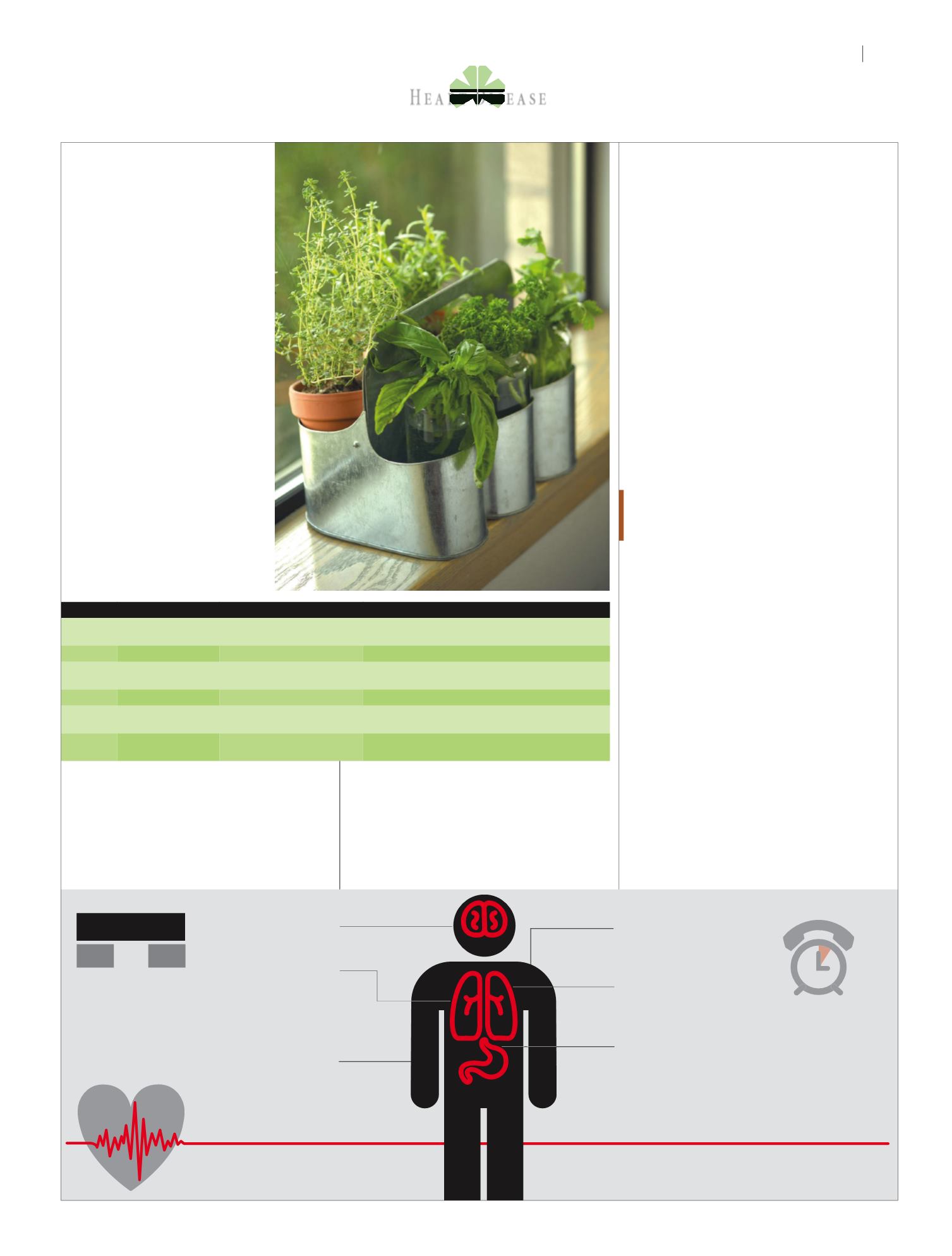
The herb What it tastes like How to handle it
What to do with it
Basil
Sweet
Chop tender leaves gently.
Pair with summer vegetables
or—surprise!—strawberries.
Chives
Oniony
Snip or chop.
Add to grilled red bliss potatoes.
Cilantro Fresh, with a citrusy
undertone
Chop tender leaves gently.
Sprinkle on grilled corn or over a fresh fruit salad.
Mint
Cool and sweet
Chop.
Toss with watermelon balls or sprinkle on fresh berries.
Oregano Earthy
Strip leaves, discard stem and
chop leaves.
Add to grilled peppers, potatoes or zucchini.
Rosemary Woodsy
Strip leaves, discard stem and
chop leaves.
Pair with grilled fish or sprinkle over fresh cut-up pears.
H D
EASY DOES IT
A coronary calcium scan can
reveal a lot about your heart
AS MEDICAL TESTS GO,
a coronary calcium scan is
a breeze for many patients. ere’s no special pre-exam
preparation, no injections and no pain. e whole thing
is over in about minutes.
Even so, this easy-to-take test provides plenty of hard
data for your doctor. It can help determine your chances
of heart problems and inform decisions about what you
should do to lower your risk.
e test uses a computed tomography (CT) scanner—
a high-tech, computer-assisted x-ray machine to make
detailed pictures of blood vessels that feed the heart.
e scan looks for tiny bits of calcium in coronary ar-
tery walls. Calcium can be an early sign of plaque buildup,
which can cause heart disease and lead to heart attack,
heart failure or unhealthy heart rhythms.
Your doctor may suggest a coronary calcium scan
if you’re at moderate risk for heart disease. at may
mean you have risk factors for the disease but no out-
ward signs of anything wrong. Risk factors may include:
Unhealthy cholesterol levels.
High blood pressure.
Diabetes.
Obesity.
A family history of heart attack.
HOW IT’S DONE
Before the scan, sticky patches are
placed on your chest. e patches are attached to wires
that lead to an electrocardiogram (EKG) machine. e
EKG monitors heart activity and times the scanner to
take images when your heart rests between beats. at’s
when the clearest pictures are possible.
You lie still on a table that glides into the CT scanner.
Whirring and clicking sounds indicate pictures are be-
ing taken.
If the scan shows signs of heart disease, your doctor
will discuss strategies to reduce your risk. ese o en
include a better diet, weight loss and more exercise.
Medications may also be recommended.
Sources: National Institutes of Health; Radiological Society of North America
Head:
Light-headedness or
sudden dizziness
Chest:
Pain, pressure,
fullness or squeezing in
the middle of the chest
that lasts more than a few
minutes or comes and goes
Skin:
Cold sweat
SPICE UP
YOUR
SUMMER
WITH
FRESH
HERBS
WHAT ARE
the best-dressed foods wear-
ing this summer? Fresh herbs, of course.
Tossed on foods fresh o the grill, chopped
and added to salads, or sprinkled over lus-
cious fruit, herbs can add tons of avor
without adding any salt or fat.
Here are six herbs to try, along with
suggestions on how to use them.
GROW YOUR OWN!
According to the U.S. Department
of Agriculture, these herbs are easy to grow in a window
box:
Basil.
Chives.
Parsley.
Rosemary.
Sage.
yme.
Be sure to pick your herbs when they’re at their
peak avor, just before they bloom. And to further help
maximize the avors and aromas of fresh herbs, chop
them very ne.
Le over herbs make great pesto. Just toss them into
the food processor with olive oil, garlic, toasted nuts and
a squirt of lemon.
Additional sources: Academy of Nutrition and Dietetics; American Heart Association
ANATOMY
OF
HEART
ATTACK
SYMPTOMS
Arm(s), back, jaw, neck,
shoulders:
Pain or
discomfort
Lungs:
Shortness of
breath with or without
chest discomfort
Stomach:
Nausea or
discomfort
MAKE THE
CALL NOW
Don’t wait more than five
minutes to call 911 if you
think you are or someone
else is having a heart
attack. Fast action can
save lives.
Coffey infographic with information
from the American Heart Association
Schedule an appointment with
one of our board-certi ed
cardiologists. Call
- - .
S U M M E R 2 0 1 4
3
H E A L T H
B E A T


